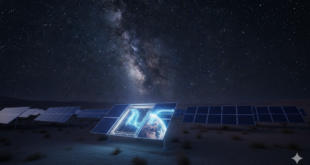As we delve into the realm of space exploration, our thirst for understanding the cosmos grows stronger. Among the countless questions and challenges we face, one concept has emerged as a potential game-changer—Space Solar Power (SSP). While we’ve explored the potential of SSP for lunar and asteroid mining, it’s crucial to consider how this transformative technology could impact planetary exploration and asteroid missions, and what new challenges might emerge on these frontiers.
Space-Based Solar Power involves capturing sunlight in space and converting it into electricity using solar panels or other advanced technologies. The key advantage of SBSP is its ability to generate energy continuously, unaffected by weather conditions or the day-night cycle on Earth. This consistent power supply could revolutionize how we meet our energy demands, offering a sustainable and reliable source of electricity.
Applying SSP to Planetary Exploration and Asteroid Missions
In addition to providing constant renewable energy to the planet, a space solar power plant could, in theory, focus its beam outward and power spacecraft, obviating the need for solar cell wings and greatly increasing power levels and control accuracy. That power could also be used in space to meet the energy demands of future space mining and resource extraction operations. NASA is examining how space solar power could support robotic mining operations on the moon or asteroids–a stepping stone toward enabling long-term human space exploration and possible colonization of the solar system beyond Earth. The energy beams could also direct power to remote areas or even dissipate destructive weather systems like typhoons.
When we shift our focus from mining to planetary exploration and asteroid missions, the advantages of SSP become even more pronounced:
1. Powering Planetary Bases: Imagine establishing a permanent base on Mars or another distant planet. SSP offers a continuous energy supply, ensuring that life support systems, habitats, and research facilities have the power they need to operate without interruption. This capability is vital for long-duration missions and the eventual colonization of other planets.
2. Exploring Asteroids: Asteroids are celestial bodies rich in resources, including water and valuable minerals. SSP enables sustained mining operations on asteroids, supporting missions aimed at resource extraction. This not only advances our understanding of these enigmatic objects but also provides essential materials for future space endeavors.
3. Beyond the Kuiper Belt: As we venture farther into the solar system, SSP becomes an indispensable asset for powering spacecraft and outposts in the Kuiper Belt and beyond. The ability to generate and transmit power in space eliminates the constraints imposed by traditional power sources.
New Challenges on the Horizon
While SSP holds tremendous promise, the transition to planetary exploration and asteroid missions introduces unique challenges:
1. Extended Transmission Distances: As we journey deeper into space, the distances between power sources and exploration sites increase significantly. Transmitting energy over such vast distances requires even more precise technologies and infrastructure. Microwave or laser beams must remain focused and efficient, traversing millions of kilometers without degradation.
2. Extreme Environmental Conditions: Planetary environments, such as Mars, present extreme temperature variations, dust storms, and radiation. SSP systems deployed on these planets must be engineered to withstand these harsh conditions and continue functioning reliably.
3. Repairs and Maintenance: Unlike Earth-based infrastructure, repairing or maintaining SSP systems on distant planets or asteroids is an extraordinary challenge. Sending crews or robotic missions to conduct repairs may not be feasible. Developing autonomous repair systems or resilient designs is paramount.
4. Regulating Space Traffic: As more nations and organizations engage in space exploration and resource utilization, the regulation of space traffic becomes increasingly complex. Coordinating the placement and operation of SSP satellites alongside other missions requires international cooperation and regulation.
Conclusion
Space Solar Power represents a transformative technology that could redefine the way we explore our solar system. As we contemplate its potential for planetary exploration and asteroid missions, we must recognize the new challenges that come with these frontiers. The journey to harnessing the power of the sun in space is fraught with technical and logistical hurdles. However, it is a journey well worth taking, as it holds the promise of unlocking the secrets of the universe, propelling us toward a sustainable future in space, and expanding human civilization beyond the confines of Earth.
Addressing these challenges will require the collaboration of nations, private companies, and research institutions. It is through such collaboration that we can overcome the obstacles and embark on a new era of space exploration, fueled by the boundless energy of the sun. In the end, the stars themselves may be within our reach, and SSP could be the key that unlocks the door to the cosmos.
 International Defense Security & Technology Your trusted Source for News, Research and Analysis
International Defense Security & Technology Your trusted Source for News, Research and Analysis




